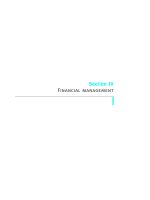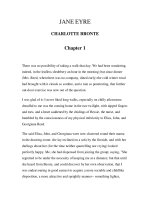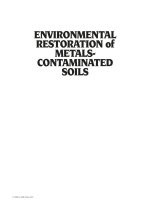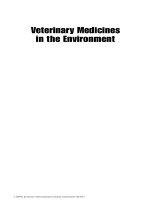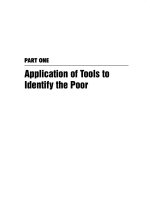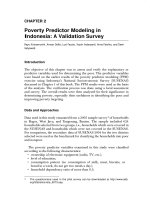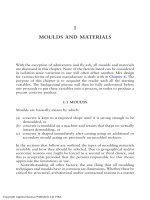Modeling Hydrologic Change: Statistical Methods - Chapter 1 pdf
Bạn đang xem bản rút gọn của tài liệu. Xem và tải ngay bản đầy đủ của tài liệu tại đây (330.82 KB, 20 trang )
LEWIS PUBLISHERS
A CRC Press Company
Boca Raton London New York Washington, D.C.
Statistical Methods
Richard H. McCuen
Department of Civil and Environmental Engineering
University of Maryland
Modeling
Hydrologic
Change
Modeling
Hydrologic
Change
© 2003 by CRC Press LLC
This book contains information obtained from authentic and highly regarded sources. Reprinted material
is quoted with permission, and sources are indicated. A wide variety of references are listed. Reasonable
efforts have been made to publish reliable data and information, but the author and the publisher cannot
assume responsibility for the validity of all materials or for the consequences of their use.
Neither this book nor any part may be reproduced or transmitted in any form or by any means, electronic
or mechanical, including photocopying, microfilming, and recording, or by any information storage or
retrieval system, without prior permission in writing from the publisher.
The consent of CRC Press LLC does not extend to copying for general distribution, for promotion, for
creating new works, or for resale. Specific permission must be obtained in writing from CRC Press LLC
for such copying.
Direct all inquiries to CRC Press LLC, 2000 N.W. Corporate Blvd., Boca Raton, Florida 33431.
Trademark Notice: Product or corporate names may be trademarks or registered trademarks, and are
used only for identification and explanation, without intent to infringe.
Visit the CRC Press Web site at www.crcpress.com
© 2003 by CRC CRC Press LLC
Lewis Publishers is an imprint of CRC Press LLC
No claim to original U.S. Government works
International Standard Book Number 1-56670-600-9
Library of Congress Card Number 2002073063
Printed in the United States of America 1 2 3 4 5 6 7 8 9 0
Printed on acid-free paper
Library of Congress Cataloging-in-Publication Data
McCuen, Richard H., 1941
Modeling hydrologic change: statistical methods / Richard H. McCuen.
p. cm.
Includes bibliographical references and index.
ISBN 1-56670-600-9
1. Hydrologic models. 2. Hydrologic—Statistical methods. I. Title.
GB656.2.H9 M33 2002
551.48′01′1—dc21 2002073063
CIP
Catalog record is available from the Library of Congress
Preface
Modeling Hydrologic Change: Statistical Methods is about modeling systems where
change has affected data that will be used to calibrate and test models of the systems
and where models will be used to forecast system responses after change occurs.
The focus is not on the hydrology. Instead, hydrology serves as the discipline from
which the applications are drawn to illustrate the principles of modeling and the
detection of change. All four elements of the modeling process are discussed:
conceptualization, formulation, calibration, and verification. Analysis and synthesis
are discussed in order to enable both model builders and users to appreciate the
importance of both aspects of modeling. The book also focuses on the art and science
of modeling.
While modeling techniques may be of great interest to hydrology-oriented pro-
fessionals, they have value to all disciplines involved in modeling changes. While
the book is oriented toward the statistical aspects of modeling, a strong background
in statistics is not required. Although the emphasis is on the analysis of temporal
and spatial sequences of data, the fundamentals that comprise most of the book are
far more applicable. Statistical and modeling methods can be applied to a broad
array of problems. This book is not appropriate as a general text for an undergraduate
introductory course in probability and statistics. It is intended for advanced under
-
graduates, graduate students, and practicing professionals.
It includes topics that serve as background material for its central focus and
topics related to the graphical and statistical detection of change and the fundamen
-
tals of modeling. While Chapters 2, 3, and 5 can be considered foundational, other
chapters also introduce basic concepts. Chapters 4 and 6 through 9 are devoted to
important graphical and statistical procedures used in modeling. Chapters 10 through
13 provide modeling tools useful in dealing with nonstationary systems.
In Chapter 2, some fundamental time-series concepts are introduced, with a
special emphasis on concepts relevant to changing systems. Changes to real systems
affect data observations. The different forms that these changes introduce into data
are defined and illustrated.
In Chapter 3, basic concepts related to the fundamentals of hypothesis testing
are introduced. While most of this material will serve as a review for readers with
background in statistical analysis, the chapter includes the basic concepts important
to understanding the statistical tests introduced in the middle chapters.
Extreme events contained in measured data are the topics of Chapter 4. They
can distort calibrated model parameters and predictions based on models. Thus, their
proper assessment and handling are essential in the early stages of modeling.
Frequency analysis is a rank-order statistical method widely used to connect the
magnitudes and probabilities of occurrence of a random variable. The basic elements
of frequency analysis as applied in hydrology are introduced in Chapter 5.
© 2003 by CRC Press LLC
While statistical methods are important tools for the detection of nonstationarity,
they are less effective when not accompanied by graphical analyses. In Chapter 6,
the uses of graphical methods in the modeling process are introduced. While graph
-
ical analysis alone is inadequate for characterizing hydrologic change, it is a nec-
essary component of the modeling process.
In Chapter 7, the fundamentals of detecting nonhomogeneity in time series are
introduced. Special emphasis is placed on selecting the statistical method most
sensitive to the types of changes to be evaluated.
Hydrologic change may be evident in the moments of the measured data or more
generally in the distribution of the data. The statistical detection of change to
moments is discussed in Chapter 8, while the detection of changes in probability
distribution is the topic of Chapter 9. Statistical methods sensitive to different types
of change are introduced in these chapters.
Chapter 10 covers many fundamentals of model calibration. Basic regression
techniques along with advanced topics such as composite modeling and jackknifing
are included.
Computer simulation is a valuable tool for modeling expected watershed
changes. The manipulation of a model to simulate alternative scenarios of change
can be valuable to decision makers. The fundamentals of simulation are presented
in Chapter 11.
Sensitivity analysis is an important tool in modeling. It is useful for making
error analyses and for assessing the relative importance of causative factors. The
mathematical basis of sensitivity analysis and its uses are discussed in Chapter 12.
Chapter 13 presents the role that geographic information systems (GIS) can play
in the assessment of hydrologic change. The inclusion of large databases in modeling
is discussed. The effects of urbanization on flood frequency analysis are shown.
© 2003 by CRC Press LLC
The Author
Richard H. McCuen, professor of civil engineering at the University of Maryland
at College Park, received degrees from Carnegie Mellon University and the Georgia
Institute of Technology. He received the Icko Iben Award from the American Water
Resource Association and was co-recipient of the 1988 Outstanding Research Award
from the American Society of Civil Engineers Water Resources Planning and Man
-
agement Division. Topics in statistical hydrology and stormwater management are
his primary research interest.
He is the author of 17 books and more than 200 professional papers, including
Modeling Hydrologic Change (CRC Press, 2002); Hydrologic Analysis and Design,
Second Edition (Prentice-Hall, 1998); The Elements of Academic Research (ASCE
Press, 1996); Estimating Debris Volumes for Flood Control (Lighthouse Publica
-
tions, 1996; with T.V. Hromadka); and Dynamic Communication for Engineers
(ASCE Press, 1993; with P. Johnson and C. Davis).
© 2003 by CRC Press LLC
Acknowledgments
Three people contributed greatly to this book. I very much appreciate Glenn
Moglen’s willingness to contribute the chapter on GIS and its role in modeling
change. This book initially was developed as a joint effort with Wilbert O. Thomas,
Jr., Baker Engineering, Alexandria, Virginia, but his workload did not permit par
-
ticipation beyond planning and review of earlier material. His insights are appreci-
ated. Finally, the assistance of Dominic Yeh, University of Maryland, for typing the
many, many drafts was essential to the completion of the manuscript. His efforts are
also very much appreciated.
Richard H. McCuen
College Park, Maryland
© 2003 by CRC Press LLC
Contents
Chapter 1 Data, Statistics, and Modeling
1.1 Introduction
1.2 Watershed Changes
1.3 Effect on Flood Record
1.4 Watershed Change
and Frequency Analysis
1.5 Detection of Nonhomogeneity
1.6 Modeling of Nonhomogeneity
1.7 Problems
Chapter 2 Introduction to Time Series Modeling
2.1 Introduction
2.2 Components of a Time Series
2.2.1 Secular Trends
2.2.2 Periodic and Cyclical Variations
2.2.3 Episodic Variation
2.2.4 Random Variation
2.3 Moving-Average Filtering
2.4 Autocorrelation Analysis
2.5 Cross-Correlation Analysis
2.6 Identification of Random Components
2.7 Autoregression and Cross-Regression Models
2.7.1 Deterministic Component
2.7.2 Stochastic Element
2.7.3 Cross-Regression Models
2.8 Problems
Chapter 3 Statistical Hypothesis Testing
3.1 Introduction
3.2 Procedure for Testing Hypotheses
3.2.1 Step 1: Formulation of Hypotheses
3.2.2 Step 2: Test Statistic and Its Sampling Distribution
3.2.3 Step 3: Level of Significance
3.2.4 Step 4: Data Analysis
3.2.5 Step 5: Region of Rejection
3.2.6 Step 6: Select Appropriate Hypothesis
3.3 Relationships among Hypothesis
Test Parameters
© 2003 by CRC Press LLC
3.4 Parametric and Nonparametric Tests
3.4.1 Disadvantages of Nonparametric Tests
3.4.2 Advantages of Nonparametric Tests
3.5 Problems
Chapter 4 Outlier Detection
4.1 Introduction
4.2 Chauvenet’s Method
4.3 Dixon–Thompson Test
4.4 Rosner’s Outlier Test
4.5 Log-Pearson Type III Outlier
Detection: Bulletin 17b
4.6 Pearson Type III Outlier Detection
4.7 Problems
Chapter 5 Statistical Frequency Analysis
5.1 Introduction
5.2 Frequency Analysis and Synthesis
5.2.1 Population versus Sample
5.2.2 Analysis versus Synthesis
5.2.3 Probability Paper
5.2.4 Mathematical Model
5.2.5 Procedure
5.2.6 Sample Moments
5.2.7 Plotting Position Formulas
5.2.8 Return Period
5.3 Population Models
5.3.1 Normal Distribution
5.3.2 Lognormal Distribution
5.3.3 Log-Pearson Type III Distribution
5.4 Adjusting Flood Record for Urbanization
5.4.1 Effects of Urbanization
5.4.2 Method for Adjusting Flood Record
5.4.3 Testing Significance of Urbanization
5.5 Problems
Chapter 6 Graphical Detection of Nonhomogeneity
6.1 Introduction
6.2 Graphical Analyses
6.2.1 Univariate Histograms
6.2.2 Bivariate Graphical Analysis
6.3 Compilation of Causal Information
6.4 Supporting Computational Analyses
6.5 Problems
© 2003 by CRC Press LLC
Chapter 7 Statistical Detection of Nonhomogeneity
7.1 Introduction
7.2 Runs Test
7.2.1 Rational Analysis of Runs Test
7.3 Kendall Test for Trend
7.3.1 Rationale of Kendall Statistic
7.4 Pearson Test for Serial Independence
7.5 Spearman Test for Trend
7.5.1 Rationale for Spearman Test
7.6 Spearman–Conley Test
7.7 Cox–Stuart Test for Trend
7.8 Noether’s Binomial Test for Cyclical Trend
7.8.1 Background
7.8.2 Test Procedure
7.8.3 Normal Approximation
7.9 Durbin–Watson Test for Autocorrelation
7.9.1 Test for Positive Autocorrelation
7.9.2 Test for Negative Autocorrelation
7.9.3 Two-Sided Test for Autocorrelation
7.10 Equality of Two Correlation Coefficients
7.11 Problems
Chapter 8 Detection of Change in Moments
8.1 Introduction
8.2 Graphical Analysis
8.3 The Sign Test
8.4 Two-Sample t-Test
8.5 Mann–Whitney Test
8.5.1 Rational Analysis of the Mann–Whitney Test
8.6 The t-Test for Two Related Samples
8.7 The Walsh Test
8.8 Wilcoxon Matched-Pairs, Signed-Ranks Test
8.8.1 Ties
8.9 One-Sample Chi-Square Test
8.10 Two-Sample F-Test
8.11 Siegel–Tukey Test for Scale
8.12 Problems
Chapter 9 Detection of Change in Distribution
9.1 Introduction
9.2 Chi-Square Goodness-of-Fit Test
9.2.1 Procedure
9.2.2 Chi-Square Test for a Normal Distribution
9.2.3 Chi-Square Test for an Exponential Distribution
© 2003 by CRC Press LLC
9.2.4 Chi-Square Test for Log-Pearson III Distribution
9.3 Kolmogorov–Smirnov One-Sample Test
9.3.1 Procedure
9.4 The Wald–Wolfowitz Runs Test
9.4.1 Large Sample Testing
9.4.2 Ties
9.5 Kolmogorov–Smirnov Two-Sample Test
9.5.1 Procedure: Case A
9.5.2 Procedure: Case B
9.6 Problems
Chapter 10 Modeling Change
10.1 Introduction
10.2 Conceptualization
10.3 Model Formulation
10.3.1 Types of Parameters
10.3.2 Alternative Model Forms
10.3.3 Composite Models
10.4 Model Calibration
10.4.1 Least-Squares Analysis of a Linear Model
10.4.2 Standardized Model
10.4.3 Matrix Solution of the Standardized Model
10.4.4 Intercorrelation
10.4.5 Stepwise Regression Analysis
10.4.6 Numerical Optimization
10.4.7 Subjective Optimization
10.5 Model Verification
10.5.1 Split-Sample Testing
10.5.2 Jackknife Testing
10.6 Assessing Model Reliability
10.6.1 Model Rationality
10.6.2 Bias in Estimation
10.6.3 Standard Error of Estimate
10.6.4 Correlation Coefficient
10.7 Problems
Chapter 11 Hydrologic Simulation
11.1 Introduction
11.1.1 Definitions
11.1.2 Benefits of Simulation
11.1.3 Monte Carlo Simulation
11.1.4 Illustration of Simulation
11.1.5 Random Numbers
11.2 Computer Generation of Random Numbers
11.2.1 Midsquare Method
© 2003 by CRC Press LLC
11.2.2 Arithmetic Generators
11.2.3 Testing of Generators
11.2.4 Distribution Transformation
11.3 Simulation of Discrete Random Variables
11.3.1 Types of Experiments
11.3.2 Binomial Distribution
11.3.3 Multinomial Experimentation
11.3.4 Generation of Multinomial Variates
11.3.5 Poisson Distribution
11.3.6 Markov Process Simulation
11.4 Generation of Continuously Distributed Random Variates
11.4.1 Uniform Distribution, U(α , β )
11.4.2 Triangular Distribution
11.4.3 Normal Distribution
11.4.4 Lognormal Distribution
11.4.5 Log-Pearson Type III Distribution
11.4.6 Chi-Square Distribution
11.4.7 Exponential Distribution
11.4.8 Extreme Value Distribution
11.5 Applications of Simulation
11.6 Problems
Chapter 12 Sensitivity Analysis
12.1 Introduction
12.2 Mathematical Foundations
of Sensitivity Analysis
12.2.1 Definition
12.2.2 The Sensitivity Equation
12.2.3 Computational Methods
12.2.4 Parametric and Component Sensitivity
12.2.5 Forms of Sensitivity
12.2.6 A Correspondence between Sensitivity and Correlation
12.3 Time Variation of Sensitivity
12.4 Sensitivity in Model Formulation
12.5 Sensitivity and Data Error Analysis
12.6 Sensitivity of Model Coefficients
12.7 Watershed Change
12.7.1 Sensitivity in Modeling Change
12.7.2 Qualitative Sensitivity Analysis
12.7.3 Sensitivity Analysis in Design
12.8 Problems
Chapter 13 Frequency Analysis under Nonstationary
Land Use Conditions
13.1 Introduction
© 2003 by CRC Press LLC
13.1.1 Overview of Method
13.1.2 Illustrative Case Study: Watts Branch
13.2 Data Requirements
13.2.1 Rainfall Data Records
13.2.2 Streamflow Records
13.2.3 GIS Data
13.3 Developing a Land-Use Time Series
13.4 Modeling Issues
13.4.1 Selecting a Model
13.4.2 Calibration Strategies
13.4.3 Simulating a Stationary Annual
Maximum-Discharge Series
13.5 Comparison of Flood-Frequency Analyses
13.5.1 Implications for Hydrologic Design
13.5.2 Assumptions and Limitations
13.6 Summary
13.7 Problems
Appendix A Statistical Tables
Appendix B Data Matrices
References
© 2003 by CRC Press LLC
© 2003 by CRC Press LLC
Data, Statistics,
and Modeling
1.1 INTRODUCTION
Before the 1960s, the availability of hydrologic data was very limited. Short records
of streamflow and precipitation were available, but soils data, maps of land cover
and use, and data on temporal watershed changes were generally not available. In
addition, the availability of computers was limited. These limitations of data and
computational firepower restricted the types of hydrologic methods that could be
developed for general use. Flood frequency analysis was a staple of hydrologic
modelers. It required limited amounts of data and was appropriate for the compu
-
tational abilities of the era.
Urbanization over the last 40 years, including suburban sprawl, and the resulting
increase in flooding necessitated new modeling tools and statistical methods. Water
-
shed change introduced effects into measured hydrologic data that limited the accu-
racy of the traditional hydrologic computations. For example, frequency analysis
assumes a stationary data sequence. The nonstationarity introduced into hydrologic
data by watershed change means that T-year (annual) maximum discharge estimates
from either predevelopment data or analyses of the nonstationary data would not be
accurate estimates of T-year discharges that would occur under the current watershed
conditions.
Two statistical advances are required to properly analyze nonstationary data.
First, more appropriate statistical tools are necessary to detect the effect of hydrologic
change and the characteristics of the change. For example, statistical methods are
needed to identify trends, with one class of statistical methods needed for gradual
trends and a second class needed for abrupt changes. Second, more sophisticated
modeling tools are needed to account for the nonstationarities introduced by water
-
shed change. For example, data measured from an urbanizing watershed would
require a model to transform or adjust the data to a common watershed condition
before a frequency analysis could be applied to the annual maximum discharge
record.
Computers, and advances in software and accessory equipment, have made new,
important types of data available that were not generally accessible even a decade
ago. For example, maps can be scanned into a computer or taken from a CD-ROM
and analyzed to create spatial measures of watershed change. Measured hydrologic
data reflect both temporal and spatial changes, and computers make it possible to
characterize these changes. The greater availability of data enables and requires more
1
© 2003 by CRC Press LLC
accurate models to account for the spatially and temporally induced nonstationarities
in the measured hydrologic data.
1.2 WATERSHED CHANGES
Watersheds, by nature, are dynamic systems; therefore, they are in a constant state
of change. While many changes are not detectable over short periods, major storms
can cause extreme changes. While the news media may focus on damage to bridges,
buildings, or dams, physical features of the watershed such as channel cross-sections
may also change drastically during major floods. Thus, natural changes to both the
land cover (e.g., afforestation) and the channel (e.g., degradation of the channel
bottom) introduce nonstationarities into measured flood records.
In addition to natural watershed changes, the response of a watershed can change
drastically due to changes associated with human activities. Changes in agricultural
management practices and urban land cover exert significant effects on the responses
of watersheds. In-stream changes, such as channelization or the construction of small
storage structures, have also had a profound effect on the watershed response to
storm rainfall. These changes will also introduce nonstationary effects in measured
data.
Changes in hydrologic response due to natural or human-induced causes can
change the storage characteristics of the watershed. Agricultural land development
often involves both land clearing, which reduces surface roughness and decreases
natural storage, and improvements in the hydraulic conveyance of the drainageways.
These changes increase the rates of runoff, which decreases the opportunity for
infiltration. Thus, peak runoff rates will increase, times to peak will decrease, and
volumes of the surface runoff will increase. With less infiltration, baseflow rates
will most likely decrease. Increases in flow velocities, which can be major causes
of flood damage, accompany the increases in runoff rates, with the higher velocities
generally increasing the scour rates of channel bottoms.
Changes in urban land cover reduce both the natural interception and depression
storages and the potential for water to infiltrate, especially where the change involves
an increase in impervious surfaces. The hydrologic effects of urban land use changes
are similar to the effects of agricultural changes. The reduction in both surface
storage and roughness increases the runoff rates and decreases computed times of
concentration. Because of the reduced potential for infiltration, the volume of surface
runoff also increases as a watershed becomes urbanized. The construction of storm
sewers and curb-and-gutter streets can also decrease the time to peak and increase
peak runoff rates.
In-stream modifications may increase or decrease channel storage and rough-
ness. Channelization (straightening and/or lining) of a stream reach reduces the
roughness, which increases flow velocities, and may decrease natural channel storage
and/or the flow length (thus increasing channel slope). The net effect is to increase
peak runoff rates. Small in-stream detention structures used in urban or rural areas
to mitigate the effects of losses of natural storage have the opposite hydrologic effect
of channelization. Specifically, the inclusion of in-stream storage decreases peak flow
rates of small storms and increases the duration of high-flow conditions. In general,
© 2003 by CRC Press LLC
the in-stream detention structure will not significantly change the total volume of
runoff but will redistribute the volume over time.
1.3 EFFECT ON FLOOD RECORD
Watershed changes can produce a nonhomogeneous flood record. The nonhomoge-
neity of the flood record reduces the reliability of the record for making estimates
of design discharges. Where ultimate-development discharge estimates are required,
an analysis of a nonhomogeneous record that does not account for the nonhomoge
-
neity could result in poor estimates of design discharges.
Watershed changes can introduce an episodic (or abrupt) change or a secular trend
in a flood series. An episodic change occurs in a very short period relative to the length
of the flood record; channelization of a stream reach would affect the flood record as
an episodic change. Once the presence and magnitude of such a change are identified,
the flood series can be adjusted to a specified condition.
When a change in watershed processes occurs over a relatively long time period,
the continual change in the flood record caused by this watershed change is referred
to as a secular change; gradual urbanization would, for example, cause a secular trend.
In such cases, the individual events in the flood record reflect different levels of the
watershed processes, and the events should be adjusted to reflect a specific watershed
state. The effect of the watershed change must be identified and quantified. To
achieve this, the type of change must be hypothesized and the cause identified. A
model that relates the discharge and a variable that represents the cause of the trend
must be developed; such a model may be linear or nonlinear, static or dynamic. The
model can then be used to adjust the flood record for a condition that would reflect
a specific state; if it is accurate, the method of adjustment would account for the
nonhomogeneous nature of the flood record.
Watershed changes that introduce a secular trend are more common in hydrologic
analysis than changes due to episodic events. The method of adjustment to account
for nonhomogeneity depends on the data available. If a calibrated watershed model
and the necessary measured rainfall data are available, then the parameters of the
model can be changed to reflect changes in watershed conditions. If the percentage
of imperviousness is the only parameter that reflects watershed urbanization, then
an appropriate adjustment method must be used in place of the more data-intensive,
watershed-modeling approach.
An annual-maximum flood series is characterized by the randomness introduced
by the variations of both rainfall and the hydrologic conditions of the watershed
when the flood-producing rainfall occurred. The floods of an annual maximum series
are produced by storms that vary in intensity, volume, duration, and the spatial char
-
acteristics of the storm cells. The extent of these sources of variation is largely
responsible for variations in flood magnitudes. Variations in watershed conditions,
especially antecedent moisture conditions, also affect variations in flood magnitudes.
In a frequency analysis of flood data, variations in both rainfall characteristics and
watershed conditions are considered to be random in nature.
Watershed changes, most notably urbanization, also can introduce variation into
the floods of an annual maximum series. Urbanization appears to increase the magnitude
© 2003 by CRC Press LLC
of floods, especially the smaller floods. Large storms on a nonurbanized watershed
saturate the watershed, which then acts as if it is impervious. Therefore, the hydro
-
logic effects of urbanization are less pronounced for the larger storm events. How-
ever, unlike the random effects of rainfall and watershed conditions, urbanization is
usually considered a deterministic factor. Specifically, urbanization introduces vari
-
ation into the floods of annual maximum series that is believed to be detectable such
that the floods can be adjusted for the effects of urbanization. The difficult task is
to isolate the variation introduced by the urbanization in the face of the random
variation due to rainfall and watershed conditions. When the random variations are
large, it may be difficult to isolate the variation due to urbanization.
Other watershed changes can be important. Channelization and channel-clearing
operations can change flood magnitudes because of their effects on hydraulic effi
-
ciency. The construction of small, unregulated detention basins can increase the
available storage in a way that reduces both the magnitude and variation of flow
rates. Intentional deforestation or afforestation are known to have significant hydro
-
logic impacts.
The detection and modeling of trends is not a new problem. Many statistical
assessments of business trends have been made. In fact, much of the seminal liter
-
ature on time series analysis is about business cycles and trends. Haan (1977) briefly
discussed fitting of trends in hydrologic data. Davis (1973) used regression tech
-
niques for fitting trends in geologic data. More recently, Gilbert (1987) provided an
extensive review of tests for detecting trends and approaches for adjusting environ
-
mental pollution data. Hirsch, Alexander, and Smith (1991) discussed methods for
detecting and estimating trends in water quality data. Systematic changes in data
from a broad spectrum of disciplines received considerable professional attention.
1.4 WATERSHED CHANGE
AND FREQUENCY ANALYSIS
A variety of watershed changes can affect the magnitude and variability of annual
peak discharges and can affect the validity of the flood-frequency estimates. Bulletin
17B, titled “Guidelines for Determining Flood Flow Frequency” by the Interagency
Advisory Committee on Water Data (IACWD) (1982; hereafter cited as Bulletin 17B),
does not provide appropriate guidance for flood-frequency analyses when watershed
changes have affected the magnitude, homogeneity, or randomness of measured
annual peak discharges. Analysis techniques are recommended herein for evaluating
and adjusting for the effects of watershed changes on the flood-frequency curve at
locations where annual peak discharges are available.
Watershed changes do not include the construction of flood-detention structures
whose operation can be regulated by human intervention. However, the construction
of small in-channel detention ponds with fixed-outlet structures is considered a water
-
shed change. In the latter case, the effect of the flood storage system is consistent
from storm to storm and is not subject to nonrandom changes in operational practices
as evidenced by human intervention. Many of the examples provided herein relate
to urbanization, but the techniques presented are applicable to watershed change due
to any factor.
© 2003 by CRC Press LLC
The techniques described in this book should be used only where physical evidence
of watershed change exists in a significant portion of the watershed. Guidelines for
determining what constitutes a significant portion of the watershed are not univer
-
sally agreed on but, as an example, Sauer et al. (1983) used watersheds that had
more than 15% of the drainage area covered with industrial, commercial, or residential
development in a nationwide study of flood characteristics for urban watersheds.
The arbitrary application of the various statistical analyses described in subse-
quent chapters may provide contradictory results. Each statistical test is based on
assumptions that may or may not be applicable to a particular situation. Ultimately,
it is the responsibility of the analyst to use hydrologic and engineering judgment in
conjunction with the statistical analyses to reach a valid conclusion.
1.5 DETECTION OF NONHOMOGENEITY
Even homogeneous flood records contain a considerable amount of random varia-
tion. Outliers exacerbate the difficulty of detecting a trend or episodic variation in
a record suspected of representing the effects of watershed change. Separating variation
associated with the trend from variation due to outliers and random variation initially
requires the detection of the trend so that it can be accurately characterized. This
then enables the trend to be modeled and separated from the random variation.
Outliers must also be detected; otherwise variation associated with an outlier may
be incorrectly attributed to the watershed change or lumped in with the random
variation.
The effects of nonhomogeneity due to watershed change should be assessed
from both graphical presentations and statistical testing of the data. Graphical anal
-
yses have the advantage of allowing the hydrologist to incorporate other information
into the decision making, such as physical processes or qualitative data associated
with independent variables. The disadvantages of graphical analyses are that they
allow for subjective interpretation and that graphing is largely limited to two or three
dimensions at a time. In addition, graphical analyses do not provide a calibrated
model of the trend, although they may infer one or more reasonable alternatives. In
spite of these disadvantages, graphical analysis is still a reasonable first step in
analyzing data collected from nonstationary hydrologic processes.
Following the graphical analyses, nonstationary data should be subjected to
analyses using statistical tests. Given the large array of available statistical tests,
knowing the characteristics and sensitivities of the alternative tests is important.
Using a test that is not sensitive to a particular type of nonhomogeneity may result
in a failure to detect the nonhomogeneity. For example, some statistical tests are
appropriate for detecting abrupt changes while others are useful for detecting gradual
trends. The use of an abrupt-change test when the data sequence involves a secular
trend over most of the period of record may lead to the incorrect determination that
the change did not significantly influence the measured data.
Statistical tests are very useful for analyzing data suspected of being nonhomoge-
neous; however, tests have their limitations. First, they do not model the effect. Instead,
the test is useful only for deciding whether a significant effect exists. Second, statistical
tests give only yes-or-no answers, that is, a test will suggest that nonhomogeneity
© 2003 by CRC Press LLC
exists in the data or it does not. Thus, the strength of the nonhomogeneity is not
qualified. Third, statistical tests require the selection of measures of risk of making
incorrect decisions. The procedures for selecting these risk levels are not systematic
and often are subjective. Thus, unless the risk measures are selected on the basis of
hydrologic considerations, the decisions may defy expectations based on knowledge
of the effects of watershed change. In spite of these disadvantages, it is always
advisable to subject data suspected of being nonstationary to statistical testing. It
provides a measure of credibility to the decision making.
1.6 MODELING OF NONHOMOGENEITY
Assuming that the graphical and statistical analyses for detection suggest that water-
shed change introduced an effect into measured data, the next task is to model the
change. The graphical analyses may have suggested a functional form that would
be appropriate. Other sources of data may suggest when the cause of the nonhomo
-
geneity began. For example, construction and building permit data may indicate
when urbanization began within a watershed and the growth of development over
time. This knowledge may then serve as input to the modeling process.
The following four stages are usually recognized in the development of models:
conceptualization, formulation, calibration, and verification. Conceptualization accounts
for as much as 80% of the effort in developing models. It involves the composite
of all of the thought processes that take place in analyzing a new problem and
devising a solution. It is an indefinable mixture of art and science (James, 1970).
Science provides a knowledge basis for conceptualization. Included in this base are
models developed for previous problems, intellectual abstractions of logical analyses
of processes, and mathematical and numerical methodologies, and the hard core of
observed hydrologic reality. However, the assembly into an “adequate and efficient”
problem solution is an art.
Tremendous freedom in practical conceptualization was gained when electronic
computers became everyday working tools. Conceptualization with no hope of
activation for prediction is meaningless in applied hydrology. The high-speed capac
-
ity of the computer opened up entirely new fields of mathematical and numerical
analyses. These new techniques, in turn, allowed wider scope in conceptualization.
Formulation, the next stage in model development, no longer placed a severe limi
-
tation on conceptualization. It was no longer necessary to gear practical conceptu-
alization to such limited formulations as closed integrals or desk calculator numerics.
The formulation stage of model development means the conversion of concepts
to forms for calculation. Formulation seems to imply a mathematical equation or
formula. Certainly, equations may be model forms. However, any algorithm or
sequence of calculations that converts inputs to outputs is an acceptable formulation.
Such a sequence may contain equations or graphical relations or it may include
“table look-up.” It may also include highly sophisticated finite difference solutions
of differential equations. Model formulation is somewhat like the preparation of a
detailed flowchart of a problem. In summary, conceptualization involves deciding
what effects the model will simulate, while formulation is the phase where functional
forms are selected to represent the concepts. Conceptualization involves determining
© 2003 by CRC Press LLC
which specific hydrologic processes are important to solving the problem at hand,
while formulation provides a structural representation of the selected processes.
A formulated model cannot provide predictions or forecasts. Before a model is
ready for use, it must be calibrated for the conditions in which it will be used. For
example, a formulated rainfall-runoff model may be equally applicable to humid
and semiarid environments because of the physical processes conceptualized and
the functional forms selected. However, the model coefficients need numerical values
before the model can be used for prediction, and the coefficients of the calibrated
rainfall-runoff model for the semiarid environment may be quite different from those
used in a model for humid environment. Calibration to the relevant conditions is a
necessary task and an important determinant of the accuracy of future predictions.
Failure at any of the first three stages (conceptualization, formulation, and cali-
bration) can be the downfall of a model. This is especially true in the modeling of
hydrologic change. Calibration represents the extraction of knowledge from data. An
improperly conceptualized or formulated model will not allow even the most sophis
-
ticated calibration method to extract the knowledge needed to understand the hydro-
logic processes modeled. Nonhomogeneous data, such as those from a watershed
undergoing change, require methods of analysis that will uncover the continually
changing importance of the hydrologic processes involved. Only by detecting and
accurately modeling changes in physical processes can a model serve its purposes.
The last stage, testing or validation, is equally important. The primary criterion
by which a model is evaluated is rationality. Does it provide accurate predictions
under a wide array of conditions, even conditions beyond the range of the data used
to calibrate the model? A model must do more than provide predictions. It must be
able to provide measures of effects, such as the effects of watershed change. Even
a model achieves high goodness-of-fit statistics during calibration may not provide
accurate assessments of effects if the fitted coefficients and the functional forms are
not rational. Sensitivity analyses and simulation studies are two tools essential to
model testing. They enable the model to be tested not only for prediction, but also
for its ability to accurately reflect the effects of changes in conditions.
1.7 PROBLEMS
1-1 Discuss how development of a 1-acre parcel of land affects the dominance
of the physical watershed processes. Assume that the predevelopment con
-
dition is woods, while after development the lot is residential.
1-2 Using Manning’s equation, discuss how clearing a stream reach of native
vegetation changes the discharge characteristics.
1-3 Would you expect urban development of 10 acres in the upper reaches of a
500-acre watershed to be detectable in a continuous flood record? Explain.
Would the effect be noticeable if the 10 acres were near the watershed outlet?
Explain.
1-4 Discuss how the effects of an episodic event, such as a hurricane, might
influence the flood record of a 200-acre watershed. Assume that the year in
which the hurricane occurred was near the middle of the flood record.
© 2003 by CRC Press LLC
1-5 What model components would be necessary for a model to be capable of
simulating the effects of watershed change?
1-6 For a 150-acre watershed, how might the installation of numerous small
stormwater-detention basins influence the flood record, including both peak
discharges and baseflow?
1-7 How might the effects of urbanization on a flood record be detected if
specific knowledge of the timing and location of gradual watershed changes
were not available?
1-8 Discuss how an outlier due to a hurricane-generated flood might make it
difficult to detect the hydrologic effects of gradual urbanization of a water
-
shed.
1-9 What effect would gradual, natural afforestation have on a record of annual-
maximum flood hydrographs over a period of 20 years? Discuss effects on
the hydrograph characteristics, not only effects on the peak.

